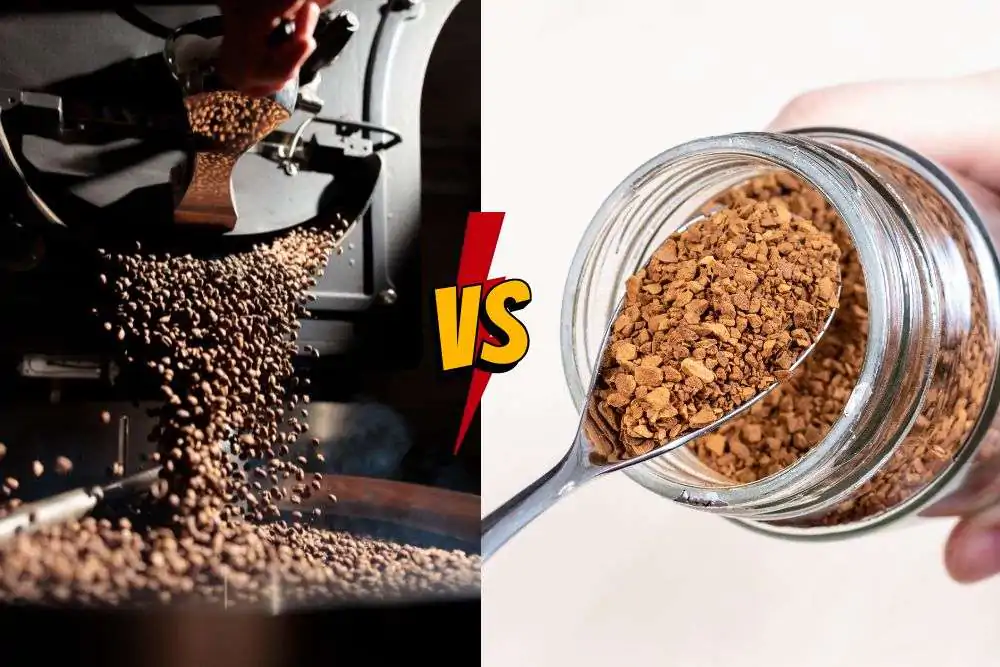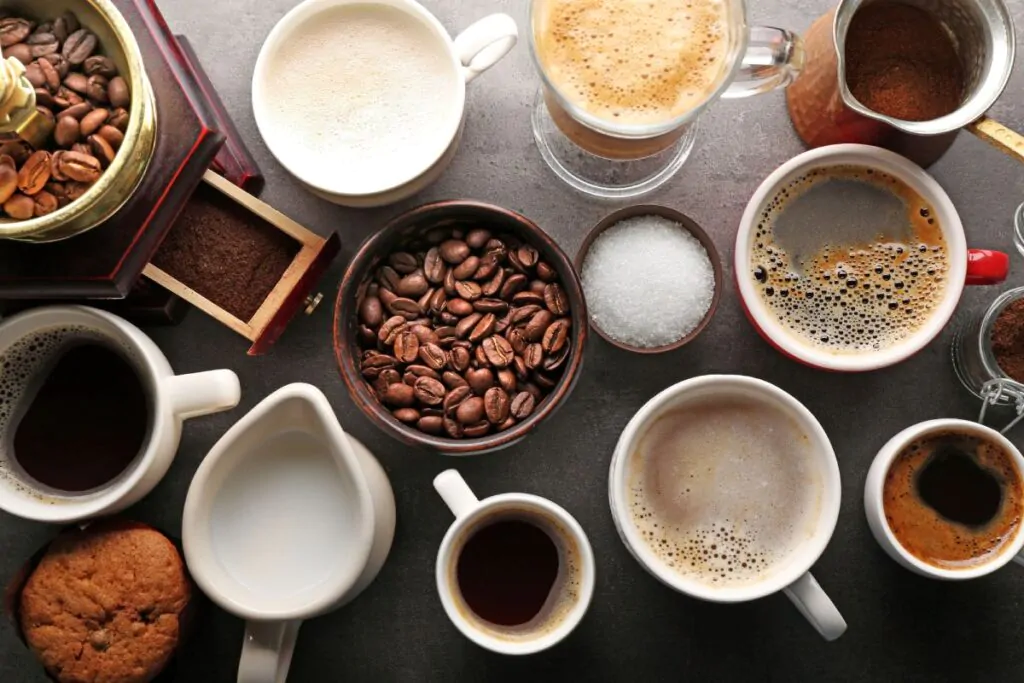Roasted coffee vs instant coffee: feelings run high on this issue. So just, which one is the best choice for you? We explore their origins and attributes.

I spent years drinking instant coffee loaded with milk and sugar. I was convinced it was almost as good as drinking freshly roasted coffee. However, when I removed the condiments from my drink, I discovered my instant coffee brand of choice was bitter and distasteful.
That said, not all instant coffees are that bad.
Let’s take a look at how these two types of coffee came to be and why the debate about which is better matters so much to us. But first, why is there such a debate between these two popular brewing methods or coffee types?
The Story Of Instant Coffee
During the United States Civil War, soldiers on both sides were anxious for a way to keep up the energy for battle, so a type of instant coffee was developed. This early instant was as thick as oil and just about as appealing. The soldiers hated it deeply, but everyone recognized that the idea was a good one.
In 1901, a scientist in the United States discovered how to create a soluble coffee and patented a process for doing it in large quantities. Not long after, the George C. Washington company made the first commercially available instant coffee, which was widely used among troops in World War I.
Returning soldiers brought their love for this instant with them, so other companies–like Nestle and Nescafe–got in on the action. World War II was another boost to instant coffee for two reasons.
First, it interfered with supplies of fresh beans for roasting. Second, soldiers in the conflict relied on instant coffee to get them through their days, and they once again brought their love for instant back home with them.
Addicted To Instant
After World War II, and for the next few decades, complicated trade, weather, and political issues in coffee-growing countries meant that most of the coffee Americans could drink was of poor quality. Early instant coffee was terrible–it had a muddy color, little taste, lots of bitterness, and was more smell than flavor.
The trouble was that ground coffee during this period was not much better. It was typically stale, over or under-roasted, and expensive.
The roasted coffee vs instant coffee debate was easy to settle: why drink inferior ground coffee at greater expense when you could drink inferior instant for a lot less? For a whole generation, instant became the favorite way to get your Java fix.
Reviving The Roasted Coffee Beans

Freshly roasted coffee got a serious makeover in the 80s and 90s, particularly with the advent of Starbucks. Once people started enjoying the richer, deeper experience of drinking freshly roasted and brewed coffee, they deserted instant in droves. Instant coffee’s market share tanked.
Fortunately, makers of instant coffee stepped up to the plate and instantly got a makeover. New processes improved the flavor and smell. Fast-forward to the 1990s, and both instant and ground coffee were undergoing a revolution. Dedicated coffee lovers found new and better ways to brew roasted coffee and manufacture instant coffee. If you like this post, you might be interested in our guide about French roast coffee.
The Pros & Cons of Both
Caffeine Content
Roasted coffee has a lot more caffeine than instant–more than twice as much!
If you like to drink coffee all day, instant is a better choice that won’t overload your system with more caffeine than it can handle. You can simply read the label, determine the caffeine content or opt for a decaf version.
If you prefer to drink a cup or two in the morning and then get on with your day, however, roasted will give you more of the good stuff.
Winner: Draw
Taste
Arabica and Robusta are the two main types of coffee beans. Arabica is sweeter and has more depth of flavor and richness, but Robusta grows more easily and is cheaper to source.
Almost all roasted coffee is Arabica, while nearly all instant is made from Robusta. The result here is that nearly everyone agrees roasted coffee tastes better, but instant is a lot cheaper. That said, the shelf life of your beans, water acidity, and condiments impact a lot on taste of regular coffee.
Winner: Roasted coffee
Convenience
Consideration is convenience is a big consideration. Here, instant wins, hands down.
Despite the advent of single-cup brewing systems and drive-thru windows, it’s still hard to think of anything faster and more convenient than a cup of instant coffee. All you need is some hot water. This is particularly true if you’re camping, traveling, or just in a big hurry.
Winner: Instant coffee
Production and Storage
To make ground coffee, you have to roast your beans to bring out their oils and sweetness. The precise roasting time varies by the type of bean and the end product desired. Once the bean is cool, you grind it up for roasting, and the sooner you drink it after the grinding, the better. If you wait too long, it goes stale.
For this reason, it’s important to get your ground coffee fresh and keep it in containers that preserve the freshness, which can be tricky. There’s no consensus on the best way to do this, and most people simply advise that you buy only as much as you can drink in a week and drink it quickly.
Instant coffee is also roasted, though we usually aren’t thinking of instant when we say “roasted coffee.” To make instant, you roast your beans, brew them, and then completely dehydrate them.
The dehydrating process turns the brewed grounds into a powder, which you can store easily and rehydrate whenever you like. While most of us don’t have these facilities, of course, instant is convenient to acquire and store, and it has a lot longer shelf life than roasted coffee.
Winner: Draw
Types of Coffee Drinks

Drinking roasted regular coffee offers more for coffee lovers than instant. Most instant brands stick to traditional options like Arabica and Robusta, as these sell the most.
Try getting a Caffé Latte or an Irish Coffee in a soluble fine powder at your local supermarket or on Amazon. And a cold brew via instant? Ugh.
Sure, you may find decaf options and even fine powder Cappuccinos, but you’ll have less control over the look and taste.
Winner: Roasted coffee
The Final Word on Roasted Coffee vs Instant Coffee
If you’re looking for the deepest, richest flavor of the biggest caffeine hit, roasted coffee should be your choice. If convenience and cost are more important to you, consider instant.
Or, try them both. If you’re a roasted coffee lover, you might be surprised at how far Instant has come these days. If a cup of instant coffee has always been your choice, investigate the depth of flavors in popular roasted coffees.
Pros
- Fast
- Cheap & Portable
- Long shelf-life
Cons
- Less healthy
- Inferior taste
- Fewer options
Either way, it never hurts to have options.
